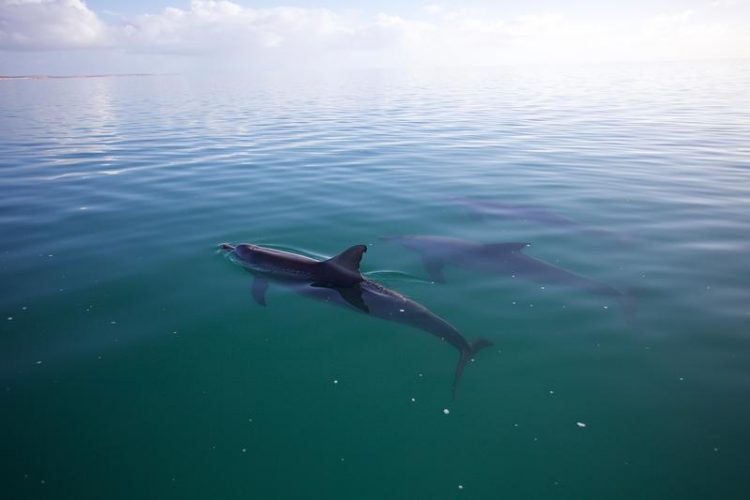Individual “Names” Reveal Complex Relationships in Male Bottlenose Dolphins

Male dolphins, despite their strong social bonds, retain their individual whistles to identify their partners and competitors. Image: Simon Allen, Dolphin Innovation Project
Dolphins are intelligent creatures that communicate with high-frequency whistles and are capable of forming strong relationships. Within their population, male dolphins enter into complex, multi-level alliances ranging from intense, lifelong friendships to loose groups. For example, during the mating season two or three males will join forces to separate a female from the group, mate with her, and fend off rivals, or even “steal” females from other groups.
Recordings of individual voice labels
Scientists at UZH, the University of Western Australia and the University of Massachusetts studied 17 adult bottlenose dolphins in Shark Bay in Western Australia. The existence of complex, multi-level alliances among males was already known from previous research on this population.
Their mutual bonds are as strong as those between mothers and their calves. Earlier research had also shown that dolphins use high-frequency whistles as a kind of “name” to introduce themselves and also to be able to identify each other, even over long distances under water
For the present study, the researchers used underwater microphones to make recordings of the dolphins’ whistles, and were able to identify each male’s individual voice label. They measured the similarity of these identifying signals, both within their immediate alliance and within another network in their community. They discovered that male dolphins, despite their strong social bonds, retain their individual whistles to identify their partners and competitors, and that these do not become adapted to each other over time.
Every male dolphin retains his own call for life
“This is a very unusual finding,” says Michael Krützen, professor of anthropology and evolutionary biology at the University of Zurich. It is common for pairs or groups of animals to converge on a similar call to build and maintain their strong bonds. It occurs, for example, among certain species of parrot, bats, elephants and primates. “With male bottlenose dolphins, precisely the opposite happens: Each male keeps his own, individual call, and distinguishes himself from his allies, even when they develop an incredibly strong bond,” explains Krützen.
The fact that the individual “names” are kept helps males to keep track of their many different relationships and distinguish between friends, friends of friends, and rivals. This way they’re able to negotiate a complex social network of cooperative relationships. “Besides humans, so far only dolphins appear to retain their individual ‘names’ when it comes to forming close, long-lasting, cooperative relationships,” states Stephanie King, lead author of the study.
Physical contact to cement relationships
Male dolphins also use physical signals such as caresses, slaps and synchronized behavior to express their social bonds. “At the moment we’re looking more closely into the relationships among the males in an alliance to find out whether or not they’re equally strong between all the individuals involved,” explains Krützen.
Literature:
Stephanie L. King, Whitney R. Friedman, Simon J. Allen, Livia Gerber, Frants H. Jensen, Samuel Wittwer, Richard C. Connor, and Michael Krützen. Bottlenose Dolphins Retain Individual Vocal Labels in Multi-Level Alliances. Current Biology, June 7, 2018. DOI: 10.1016/j.cub.2018.05.013
Contact:
Prof. Michael Krützen, PhD
Department of Anthropology
University of Zurich
Phone: +41 44 635 54 12
E-mail: michael.kruetzen@aim.uzh.ch
Dr. Stephanie King
School of Biological Sciences
University of Western Australia
Crawley, WA, Australia
E-mail: stephanie.king@uwa.edu.au
Media Contact
More Information:
http://www.uzh.ch/All latest news from the category: Life Sciences and Chemistry
Articles and reports from the Life Sciences and chemistry area deal with applied and basic research into modern biology, chemistry and human medicine.
Valuable information can be found on a range of life sciences fields including bacteriology, biochemistry, bionics, bioinformatics, biophysics, biotechnology, genetics, geobotany, human biology, marine biology, microbiology, molecular biology, cellular biology, zoology, bioinorganic chemistry, microchemistry and environmental chemistry.
Newest articles

Properties of new materials for microchips
… can now be measured well. Reseachers of Delft University of Technology demonstrated measuring performance properties of ultrathin silicon membranes. Making ever smaller and more powerful chips requires new ultrathin…

Floating solar’s potential
… to support sustainable development by addressing climate, water, and energy goals holistically. A new study published this week in Nature Energy raises the potential for floating solar photovoltaics (FPV)…

Skyrmions move at record speeds
… a step towards the computing of the future. An international research team led by scientists from the CNRS1 has discovered that the magnetic nanobubbles2 known as skyrmions can be…





















